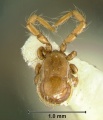Aenictus gracilis
| Aenictus gracilis | |
|---|---|

| |
| Scientific classification | |
| Kingdom: | Animalia |
| Phylum: | Arthropoda |
| Class: | Insecta |
| Order: | Hymenoptera |
| Family: | Formicidae |
| Subfamily: | Dorylinae |
| Genus: | Aenictus |
| Species: | A. gracilis |
| Binomial name | |
| Aenictus gracilis Emery, 1893 | |
| Synonyms | |
| |
An army ant that preys on other ant species.
Identification
Jaitrong and Yamane (2011) - A member of the currax group. Aenictus gracilis is most similar to Aenictus cornutus in colouration and structure, both sharing the entirely sculptured mesopleuron, metapleuron, propodeum, and petiole. However, this species is distinguished from the latter by the following characteristics: pronotum without horns (pronotum armed with large bilateral horn-like protuberances in A. cornutus); antennal scape, postpetiole, and legs smooth and shiny (entirely punctate in A. cornutus); petiole with dense fine punctures (with dense punctures and bearing longitudinal ridges or rugae in A. cornutus). These two species are sympatric in Borneo, Sumatra and Malay Peninsula.
Keys including this Species
Distribution
Latitudinal Distribution Pattern
Latitudinal Range: 9.307° to 1.383329988°.
| North Temperate |
North Subtropical |
Tropical | South Subtropical |
South Temperate |
- Source: AntMaps
Distribution based on Regional Taxon Lists
Indo-Australian Region: Borneo, Indonesia, Malaysia, Philippines, Singapore.
Oriental Region: Bangladesh, India, Myanmar, Sri Lanka (type locality), Vietnam.
Distribution based on AntMaps
Distribution based on AntWeb specimens
Check data from AntWeb
Countries Occupied
| Number of countries occupied by this species based on AntWiki Regional Taxon Lists. In general, fewer countries occupied indicates a narrower range, while more countries indicates a more widespread species. |

|
Estimated Abundance
| Relative abundance based on number of AntMaps records per species (this species within the purple bar). Fewer records (to the left) indicates a less abundant/encountered species while more records (to the right) indicates more abundant/encountered species. |

|
Biology
Jaitrong and Yamane (2011) - A. gracilis is widespread and dominant in the rainforests of Southeast Asia (Gotwald 1995). The material examined was mainly collected from Sundaland; only two colonies were from the Philippines (Luzon and Nergros islands), and a single colony from western Thailand. Most of these were collected from lowland primary rainforests (less than 500 m alt.). Rościszewski and Maschwitz (1994) studied this species in lowland rainforests in Pasoh Forest Reserve, Peninsular Malaysia. Hirosawa et al. (2000) followed many colonies of this species between 600 and 800 m alt. in Sabah, Borneo during his ecological survey on army ants. Schneirla and Reyes (1966) also found many colonies of A. gracilis in open areas around 800 m alt. both day and night in the Philippines. Thus, this species probably ranges from lowland up to 800 m and inhabits both primary and disturbed forests.
Schneirla and Reyes (1966) conducted an ecological study of A. gracilis and Aenictus laeviceps in the Philippines and briefly reported that their food habits are similar to each other, commomnly hunting ant species of the genera Polyrhachis, Camponotus, Crematogaster, and Pheidole, although booty size is generally smaller in A. gracilis. In contrast Rościszewski and Maschwitz (1994) found that sympatric species of Aenictus in Pasoh Forest Reserve, Peninsular Malaysia, reduced competition for the same resources by differentially preferring specific taxa, by foraging in different strata or by favoring a particular prey size. The food habits were remarkably different between A. gracilis and A. laeviceps. Their results were supported by Hirosawa et al. (2000), who found A. gracilis forages more frequently on trees and in their canopies than A. laeviceps, which usually forages on the forest floor. Thus, the main prey are arboreal ants in A. gracilis and ground ants in A. laeviceps. Hirosawa et al. (2000) reported that dominant prey genera were Technomyrmex (52.1%), Nylanderia and/or Paraparatrechina (referred to as Paratrechina) (22.4%) and Crematogaster (11.9%) in the vicinity of Poring, Sabah, Borneo at altitudes of 600–800 m. J. W. Chapman (cited in Wilson 1964) observed that A. gracilis preyed on other ants such as Anoplolepis gracilipes (referred to as longipes), Colobopsis leonardi, Camponotus sp., Crematogaster sp., Leptogenys sp., Paratrechina longicornis, Pheidole sp., Polyrhachis dives, Polyrhachis sp., and also on the social wasp, Ropalidia flavopicta. Chapman (1964) found this species feeding on myriapods, termites, and small staphylinid beetles. Rościszewski and Maschwitz (1994) recorded ants of the genera Acropyga, Nylanderia and/or Paraparatrechina (as Paratrechina), Technomyrmex, and Prenolepis as the prey of A. gracilis'.
Association with Other Organisms
 Explore: Show all Associate data or Search these data. See also a list of all data tables or learn how data is managed.
Explore: Show all Associate data or Search these data. See also a list of all data tables or learn how data is managed.
- This species is a prey for the phorid fly Aenictomyia chapmani (a predator) (Disney et al., 1998).
- This species is a prey for the phorid fly Dohrniphora kistneri (a predator) (Disney et al., 1998).
- This species is a prey for the phorid fly Dohrniphora sp. N (a predator) (Disney et al., 1998; Quevillon, 2018).
- This species is a prey for the phorid fly Vestigipoda maschwitzi (a predator) in Malaysia (Disney et al., 1998).
Castes
Gotwald and Leroux (1980) - Workers of the genus Aenictus are essentially monomorphic (Schneirla, 1971; Topoff, 1971) with only a small difference in total length between the smallest and largest workers in any one colony. For the Asian species A. gracilis, this difference was calculated to be 0.5 mm within one colony that was examined (Schneirla, 1971).
       
| |
| . | Owned by Museum of Comparative Zoology. |
Images from AntWeb
   
| |
| Worker. Specimen code casent0249275. Photographer Shannon Hartman, uploaded by California Academy of Sciences. | Owned by PSWC, Philip S. Ward Collection. |
   
| |
| Paralectotype of Aenictus gracilis. Worker. Specimen code casent0903747. Photographer Will Ericson, uploaded by California Academy of Sciences. | Owned by MSNG, Genoa, Italy. |
   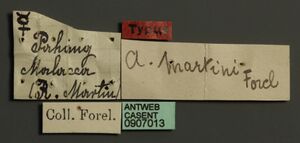
| |
| Syntype of Aenictus martini. Worker. Specimen code casent0907013. Photographer Will Ericson, uploaded by California Academy of Sciences. | Owned by MHNG, Geneva, Switzerland. |
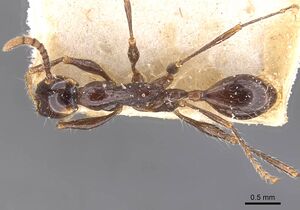   
| |
| Syntype of Aenictus martini boelianensis. Worker. Specimen code casent0907014. Photographer Will Ericson, uploaded by California Academy of Sciences. | Owned by MHNG, Geneva, Switzerland. |
- Male
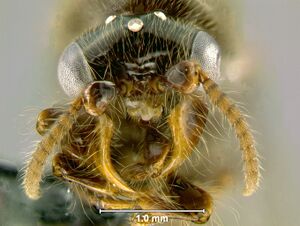  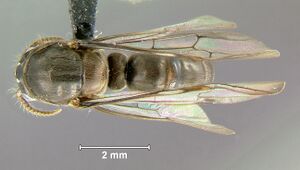 
| |
| . | Owned by Museum of Comparative Zoology. |
Nomenclature
The following information is derived from Barry Bolton's Online Catalogue of the Ants of the World.
- gracilis. Aenictus gracilis Emery, 1893e: 187, pl. 8, fig. 1 (w.) BORNEO (East Malaysia: Sarawak).
- Type-material: lectotype worker (by designation of Jaitrong & Yamane, 2011: 17), 6 paralectotype workers.
- Type-locality: lectotype Malaysia: Borneo, Sarawak (Bedot & Pictet); paralectotypes with same data.
- Type-depository: MSNG.
- Combination in A. (Typhlatta): Wheeler, W.M. 1930g: 199.
- Wheeler, G.C. & Wheeler, J. 1990a: 460 (l.).
- Status as species: Emery, 1910b: 30; Wheeler, W.M. 1919e: 62; Wheeler, W.M. 1930g: 199 (in key); Chapman & Capco, 1951: 13; Wilson, 1964a: 463; Terayama & Yamane, 1989: 599; Bolton, 1995b: 59; Mohanraj, et al. 2010: 6; Jaitrong & Yamane, 2011: 16 (redescription); Pfeiffer, et al. 2011: 32; Bharti, Wachkoo & Kumar, 2012: 293 (in key).
- Senior synonym of boelianensis: Wilson, 1964a: 463; Terayama & Yamane, 1989: 599; Bolton, 1995b: 59; Jaitrong & Yamane, 2011: 16.
- Senior synonym of elongatus: Wilson, 1964a: 463; Terayama & Yamane, 1989: 599; Bolton, 1995b: 59.
- Senior synonym of martini: Wilson, 1964a: 463; Terayama & Yamane, 1989: 599; Bolton, 1995b: 59; Jaitrong & Yamane, 2011: 16.
- Distribution: Brunei, Indonesia (Kalimantan, Sumatra), Malaysia (Peninsula, Sabah, Sarawak), Myanmar, Philippines (Luzon, Negros), Thailand.
- boelianensis. Aenictus martini var. boelianensis Forel, 1913k: 20 (w.) INDONESIA (Sumatra).
- Type-material: syntype workers (number not stated).
- Type-localities: Indonesia: Sumatra, Bah Boelian, and Sumatra, Bah Soemboe (H. v. Buttel-Reepen).
- Type-depositories: MHNG, NHMB.
- [Misspelled as boelieanensis by Baroni Urbani, 1977e: 68.]
- Subspecies of martini: Chapman & Capco, 1951: 14.
- Junior synonym of gracilis: Wilson, 1964a: 463; Terayama & Yamane, 1989: 599; Bolton, 1995b: 59; Jaitrong & Yamane, 2011: 16.
- elongatus. Eciton (Aenictus) fergusoni subsp. elongatus Karavaiev, 1926d: 424, fig. 3 (w.) SRI LANKA.
- Type-material: syntype workers (number not stated, “several”).
- Type-locality: Sri Lanka (“Ceylon”): Ramboda, 3500 ft, 8.xii.1912 (O. John).
- Type-depository: SIZK.
- Combination in A. (Typhlatta): Wheeler, W.M. 1930g: 199.
- Status as species: Wheeler, W.M. 1930g: 199 (in key).
- Subspecies of fergusoni: Chapman & Capco, 1951: 13.
- Junior synonym of gracilis: Wilson, 1964a: 463; Terayama & Yamane, 1989: 599; Bolton, 1995b: 59.
- martini. Aenictus martini Forel, 1901a: 473 (w.) WEST MALAYSIA, MYANMAR.
- Type-material: syntype workers (number not stated).
- Type-localities: Malaysia (Malacca): Pahang (R. Martin), Perak (R. Martin), and Myanmar (“Burma”): Moulmain (Hodgson).
- Type-depositories: MHNG, NHMB.
- Combination in A. (Typhlatta): Wheeler, W.M. 1930g: 199.
- Wheeler, W.M. 1930g: 203 (q.); Chapman, 1963: 251 (m.); Wheeler, G.C. 1943: 326 (l.).
- Status as species: Bingham, 1903: 17; Emery, 1910b: 30; Forel, 1911d: 382; Forel, 1911e: 255; Forel, 1913k: 20; Wheeler, W.M. & Chapman, 1925: 47; Wheeler, W.M. 1930g: 198 (in key); Chapman & Capco, 1951: 13; Chapman, 1963: 251; Baltazar, 1966: 232.
- Junior synonym of gracilis: Wilson, 1964a: 463; Bolton, 1995b: 60; Terayama & Yamane, 1989: 599; Jaitrong & Yamane, 2011: 16.
Description
Worker
Jaitrong and Yamane (2011) - Measurements. Worker lectotype and paralectotypes (n =7): TL 3.60–3.80 mm; HL 0.70–0.78 mm; HW 0.63– 0.68 mm; SL 0.52–0.65 mm; ML 1.20–1.30 mm; PL 0.25–0.30 mm; CI 80–90; SI 84–104.
(lectotype and paralectotypes). Head in full-face view clearly longer than broad, with sides convex and posterior margin almost straight and weakly sinuate; occipital carina distinct. Antenna relatively long; scape almost reaching posterolaterial corner of head; antennal segments II–X each longer than broad; II almost as long as each of III–VI. Frontal carina extending beyond the level of posterior margin of torulus, well developed anteriorly and gradually becoming evanescent posteriorlly. Parafrontal ridge short and bluntly pointed at apex. Masticatory margin of mandible with a large apical tooth followed by a medium-sized subapical tooth and 6–8 denticles; basal margin lacking denticles. Mesosoma slender; promesonotum in profile weakly convex dorsally and sloping gradually to metanotal groove; mesothorax almost cylindrical and demarcated from propodeum by a groove laterally, and by a shallow metanotal groove dorsally. Propodeum in profile with weakly convex dorsal outline; propodeal junction angulate; declivity of propodeum shallowly concave, and encircled with a thin rim; opening of propodeal spiracle clearly circular with its diameter about 1.5–2.0 times as long as diameter of postpetiolar spiracle. Petiole distinctly longer than high, with its dorsal outline weakly convex; subpetiolar process weakly developed, low but often triangular anteriorly, with its ventral outline almost straight, and anteroventral corner angulate. Postpetiole slightly longer than high, with its dorsal outline elevated posteriorlly.
Head including mandible and antennal scape extensively smooth and shiny; basal 1/3 of scape finely sculptured. Pronotum and mesonotum smooth and shiny except for the anteriormost portion of pronotum which is punctate; mesopleuron and propodeum with dense punctures. In addition, propodeum bearing several thin, straight, longitudinal rugae. Petiole with dense punctures, while postpetiole dorsally smooth and shiny, on occasion laterally superficially sculptured. Legs smooth and shiny.
Head and mesosoma dorsally with relatively sparse long standing hairs mixed with sparse short hairs; longest pronotal hair 0.40 mm long. Entire body dark reddish-brown. Typhlatta spot located at occipital corner.
Type Material
- Eciton (Aenictus) fergusoni elongatus Karavaiev, 1926: Syntype, 2 workers, Ramboda (Ceylon), Sri Lanka, John,C., ANIC32-017905, Australian National Insect Collection.
References
- Borowiec, M.L. 2019. Convergent evolution of the army ant syndrome and congruence in big-data phylogenetics. Systematic Biology 68, 642–656 (doi:10.1093/sysbio/syy088).
- Chapman, J. W. 1963. Some new and interesting Philippine ants (Hymenoptera: Formicidae). Philipp. J. Sci. 92: 247-263.
- Disney, R.H.L., Weissflog, A., Maschwitz, U. 1998. A second species of legless scuttle fly (Diptera: Phoridae) associated with ants (Hymenoptera: Formicidae). Journal of Zoology, 246(3), 269–274. (doi:10.1111/j.1469-7998.1998.tb00157.x).
- Emery, C. 1893g. Formicides de l'Archipel Malais. Rev. Suisse Zool. 1: 187-229 (page 187, pl. 8, fig. 1 worker described)
- Forel, A. 1901. Les formicides de l’Empire des Indes et de Ceylan. Part 8. Sous famille Dorylinae. Journal of the Bombay Natural History Society, 13, 462–477.
- Forel, A. 1913. Wissenschaftliche Ergebnisse einer Forschungsreise nach ostindien, ausgeführt im Auftrage der Kgl. Preuss. Akademie der Wissenschaften zu Berlin von H. v. Buttel-Reepen. 2. Ameisen aus Sumatra, Java, Malacca und Ceylon. Gesammelt von Herrn Prof. Dr. v. Buttel-Reepen in den Jahren 1911–1912. Zoologische Jahrbucher. Abteilung für Systematik, Geographie und Biologie der Tiere, 36, 1–148.
- Jaitrong, W. & Yamane, S. 2011. Synopsis of Aenictus species groups and revision of the A. currax and A. laeviceps groups in the eastern Oriental, Indo-Australian, and Australasian regions (Hymenoptera: Formicidae: Aenictinae). Zootaxa, 3128, 1–46.
- Khachonpisitsak, S., Yamane, S., Sriwichai, P., Jaitrong, W. 2020. An updated checklist of the ants of Thailand (Hymenoptera, Formicidae). ZooKeys 998, 1–182 (doi:10.3897/zookeys.998.54902).
- Radchenko, A.G., Fisher, B.L., Esteves, F.A., Martynova, E.V., Bazhenova, T.N., Lasarenko, S.N. 2023. Ant type specimens (Hymenoptera, Formicidae) in the collection of Volodymyr Opanasovych Karawajew. Communication 1. Dorylinae, Poneromorpha and Pseudomyrmecinae. Zootaxa, 5244(1), 1–32 (doi:10.11646/zootaxa.5244.1.1).
- Wang, W.Y., Soh, E.J.Y., Yong, G.W.J., Wong, M.K.L., Benoit Guénard, Economo, E.P., Yamane, S. 2022. Remarkable diversity in a little red dot: a comprehensive checklist of known ant species in Singapore (Hymenoptera: Formicidae) with notes on ecology and taxonomy. Asian Myrmecology 15: e015006 (doi:10.20362/am.015006).
- Wheeler, G. C.; Wheeler, J. 1990a [1989]. Notes on ant larvae. Trans. Am. Entomol. Soc. 115: 457-473 (page 460, larva described)
- Wilson, E. O. 1964a. The true army ants of the Indo-Australian area (Hymenoptera: Formicidae: Dorylinae). Pac. Insects 6: 427-483 (page 463, senior synonym of boelianensis, elongatus and martini)
- Yamane, S., Tanaka, H.O., Hasimoto, Y., Ohashi, M., Meleng, P., Itioka, T. 2021. A list of ants from Lambir Hills National Park and its vicinity, with their biological information: Part II. Subfamilies Leptanillinae, Proceratiinae, Amblyoponinae, Ponerinae, Dorylinae, Dolichoderinae, Ectatomminae and Formicinae. Contributions from the Biological Laboratory, Kyoto University 31, 87–157.
References based on Global Ant Biodiversity Informatics
- Baroni Urbani C. 1977. Katalog der Typen von Formicidae (Hymenoptera) der Sammlung des Naturhistorischen Museums Basel (2. Teil). Mitt. Entomol. Ges. Basel (n.s.) 27: 61-102.
- Bharti H. 2011. List of Indian ants (Hymenoptera: Formicidae). Halteres 3: 79-87.
- CSIRO Collection
- Chapman J. W. 1965. Studies on the ecology of the army ants of the Philippines genus Aenictus Schuckard (Hymenoptera: Formicidae). Philippine Journal of Science. 93: 551-595.
- Chapman J. W. 1963. Some new and interesting Philippine ants (Hymenoptera: Formicidae). Philipp. J. Sci. 92: 247-263.
- Chapman, J. W., and Capco, S. R. 1951. Check list of the ants (Hymenoptera: Formicidae) of Asia. Monogr. Inst. Sci. Technol. Manila 1: 1-327
- Chapman, J.W. and S.R. Capco. 1951. Check list of the ants (Hymenoptera: Formicidae) of Asia. Monographs of the Institute of Science and Technology (Manila) 1: 1- 327
- Davidson D. W., S. C. Cook, R. R. Snelling and T. H. Chua. 2003. Explaining the Abundance of Ants in Lowland Tropical Rainforest Canopies. Science 300: 969-972.
- Dias R. K. S. 2013. Diversity and importance of soil-dweeling ants. Proceedings of the National Symposium on Soil Biodiversity, chapt 4, pp 19-22.
- Eguchi K., and S. Yamane. 2003. Species diversity of ants (Hymenoptera, Formicidae) in a lowland rainforest, northwestern Borneo. New Entomol. 52(1,2): 49-59.
- Emery C. 1893. Formicides de l'Archipel Malais. Revue Suisse de Zoologie 1: 187-229.
- Emery C. 1910. Hymenoptera. Fam. Formicidae. Subfam. Dorylinae. Genera Insectorum 102: 1-34.
- Emery, C. "Voyage de MM. Bedot et Pictet dans l'Archipel Malais. Formicides de l'Archipel Malais." Revue Suisse de Zoologie 1 (1893): 187-229.
- Forel A. 1911. Die Ameisen des K. Zoologischen Museums in München. Sitzungsber. Math.-Phys. Kl. K. Bayer. Akad. Wiss. Münch. 11: 249-303.
- Forel A. 1911. Fourmis nouvelles ou intéressantes. Bull. Soc. Vaudoise Sci. Nat. 47: 331-400.
- Forel A. 1913k. Wissenschaftliche Ergebnisse einer Forschungsreise nach Ostindien ausgeführt im Auftrage der Kgl. Preuss. Akademie der Wissenschaften zu Berlin von H. v. Buttel-Reepen. II. Ameisen aus Sumatra, Java, Malacca und Ceylon. Gesammelt von Herrn Prof. Dr. v. Buttel-Reepen in den Jahren 1911-1912. Zoologische Jahrbücher. Abteilung für Systematik, Geographie und Biologie der Tiere 36:1-148.
- Hashimoto Y., Y. Morimoto, and M. Mohamed. 2003. Species List of Ground and Leaf Litter Ants Collected in Lower Kinabatangan. Pp 13-18. In Lower Kinabatangan Scientific Expedition 2002, 176 pp. ISBN-13: 983-2369-11-8
- Hashimoto Y., and S. Yamane. 1998. Army ants and ant collectors [1]--In quest of Asian army ants (Aenictinae) Insectarium 35: 4-8.
- Hashimoto Y., and S. Yamane. 2014. Comparison of foraging habits between four sympatric army ant species of the genus Aenictus in Sarawak, Borneo. Asian Myrmecology 6: 95-104.
- Jaitrong W. 2015. A revision of the Thai species of the ant genus Aenictus Shuckard, 1840 (Hymenoptera: Formicidae: Dorylinae). The Thailand Natural History Museum Journal 9(1): 1-94.
- Jaitrong W.; Yamane, S. 2011. Synopsis of Aenictus species groups and revision of the A. currax and A. laeviceps groups in the eastern Oriental, Indo-Australian, and Australasian regions (Hymenoptera: Formicidae: Aenictinae). Zootaxa 3128:1-46.
- Karavaiev V. 1926. Ameisen aus dem Indo-Australischen Gebiet. Treubia 8: 413-445.
- Malsch A. K. F., K. Rosciszewski, and U. Maschwitz. 2003. The ant species richness and diversity of a primary lowland rain forest, the Pasoh Forest reserve, West Malaysia. in T. Okuda, N. Manokaran, Y. Matsumoto, K. Niiyama, S. C. Thomas, and P. S. Ashton, eds. Pasoh: Ecology and Natural History of a Southeast Asin Lowland Tropical Rain Forest, pp 347-374.
- Matsumoto T., T. Itioka, S. Yamane, and K. Momose. 2009. Traditional land use associated with swidden agriculture chnages encounter rates of the top predator, the army ant, in Southern Asian tropical rain forests. Biodivers. Conserv. 18: 3139-3151.
- Mohamed M. 1995. A preliminary list of ants (Hymenoptera: Formicidae) of the Tawau Hills Park, Sabah. In: Ghazally Ismail et al. (eds.), Tawau Hills Park, Sabah, Pelanduk Pub. Pp. 205-213.
- Pfeiffer M., D. Mezger, and J. Dyckmans. 2013. Trophic ecology of tropical leaf litter ants (Hymenoptera: Formicidae) - a stable isotope study in four types of Bornean rain forest. Myrmecological News 19: 31-41.
- Pfeiffer M.; Mezger, D.; Hosoishi, S.; Bakhtiar, E. Y.; Kohout, R. J. 2011. The Formicidae of Borneo (Insecta: Hymenoptera): a preliminary species list. Asian Myrmecology 4:9-58
- Philpott S.M., P. Bichier, R.A. Rice, and R. Greenberg. 2008. Biodiversity conservation, yield, and alternative products in coffee agroecosystems in Sumatra, Indonesia. Biodivers. Conserv. 17: 1805-1820. Data obtained from Stacy Philpott
- Sukimin S., M. Mohamed, and H. Aris. 2010. Ant diversity of Maliau Basin Conservation Area, Sabah, Malaysia. Journal of Tropical Biology and Conservation 6:89-101.
- Terayama M.; Yamane, S. 1989. The army ant genus Aenictus (Hymenoptera, Formicidae) from Sumatra, with descriptions of three new species. Japanese Journal of Entomology 57:597-603.
- Wheeler W. M. 1919. The ants of Borneo. Bulletin of the Museum of Comparative Zoology 63:43-147.
- Wheeler W. M. 1930. Philippine ants of the genus Aenictus with descriptions of the females of two species. Journal of the New York Entomological Society 38: 193-212.
- Wheeler W. M., and J. W. Chapman. 1925. The ants of the Philippine Islands. Part I, Dorylinae and Ponerinae. Philipp. J. Sci. 28: 47-73.
- Wilson E. O. 1964. The true army ants of the Indo-Australian area (Hymenoptera: Formicidae: Dorylinae). Pacific Insects 6: 427-483.
- Yamane S.; Nona, A. R. 1994. Ants from Lambir Hills National Park, Sarawak. Pp. 222-226 in: Inoue, T.; Hamid, A. A. (eds.) 1994. Plant reproductive systems and animal seasonal dynamics. Long-term study of dipterocarp forests in Sarawak. Kyoto: Center for Ecological Research, Kyoto University, vii + 255 pp.
- Yusah K. M., T. M. Fayle, G. Harris, and W. A. Foster. 2012. Optimizing diversity assesment protocols for high canopy ants in tropical rain forest. Biotropica 44(1): 73-81.
- Zryanin V. A. 2011. An eco-faunistic review of ants (Hymenoptera: Formicidae). In: Structure and functions of soil communities of a monsoon tropical forest (Cat Tien National Park, southern Vietnam) / A.V. Tiunov (Editor). – M.: KMK Scientific Press. 2011. 277 р.101-124.


